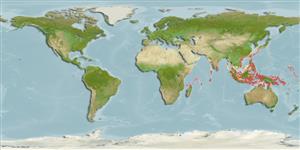>
Ovalentaria/misc (Various families in series Ovalentaria) >
Pomacentridae (Damselfishes) > Pomacentrinae
Etymology: Neoglyphidodon: Greek, para = the side of + Greek, glyphis = carved + Greek, odous = teeth.
More on author: Bleeker.
Environment: milieu / climate zone / depth range / distribution range
экология
морской ассоциированный с рифами; немигрирующий; пределы глубины 1 - 20 m (Ref. 7247). Tropical; 45°N - 14°S
Indo-West Pacific: Sri Lanka to the Indo-Australian Archipelago including Sumatra, Java, Sulawesi, and the Solomon Islands. Records from other locations are mostly misidentifications.
Size / Вес / Возраст
Maturity: Lm ? range ? - ? cm
Max length : 13.5 cm TL самец/пол неопределен; (Ref. 90102)
Краткое описание
определительные ключи | морфология | морфометрия
колючие лучи спинного плавника (общее число) : 13; членистые (мягкие) лучи спинного плавника (общее число) : 15 - 16; колючие лучи анального плавника: 2; членистые (мягкие) лучи анального плавника: 13 - 15.
Adults inhabit coral reefs (Ref. 9710), probably subject to surge to 20 m depth. Poorly known species that is seldom seen. Probably overlooked because of the drab appearance. Juveniles unknown and probably have large ocellus like N. thoracotaeniatus (Ref. 48636). Life history characteristics for the family specify that this group is oviparous, with distinct pairing during breeding (Ref. 205). Eggs are demersal and adhere to the substrate (Ref. 205). Males guard and aerate the eggs (Ref. 205). Diurnal species (Ref. 113699).
Life cycle and mating behavior
половая зрелость | размножение | нерест | икра | Fecundity | личинки
Life history characteristics for the family specify that this group is oviparous, with distinct pairing during breeding (Ref. 205). Eggs are demersal and adhere to the substrate (Ref. 205). Males guard and aerate the eggs (Ref. 205).
Allen, G.R., 1991. Damselfishes of the world. Mergus Publishers, Melle, Germany. 271 p. (Ref. 7247)
Статус Красного Списка МСОП (Ref. 130435: Version 2024-1)
Угроза для людей
Harmless
Использование человеком
рыболовство: коммерческий; аквариум: коммерческий
дополнительная информация
инструменты
Специальные отчеты
Скачать в формате XML
ресурсы в Интернет
Estimates based on models
Preferred temperature (Ref.
123201): 28.2 - 29.3, mean 28.8 °C (based on 731 cells).
Phylogenetic diversity index (Ref.
82804): PD
50 = 0.5020 [Uniqueness, from 0.5 = low to 2.0 = high].
Bayesian length-weight: a=0.02344 (0.01134 - 0.04848), b=2.98 (2.80 - 3.16), in cm total length, based on LWR estimates for this (Sub)family-body shape (Ref.
93245).
Trophic level (Ref.
69278): 2.7 ±0.3 se; based on size and trophs of closest relatives
устойчивость к внешним воздействиям (Ref.
120179): высокий, минимальное время удвоения популяции до 15 месяцев (Preliminary K or Fecundity.).
Fishing Vulnerability (Ref.
59153): Low vulnerability (10 of 100).
Nutrients (Ref.
124155): Calcium = 92.4 [47.2, 147.8] mg/100g; Iron = 0.684 [0.407, 1.111] mg/100g; Protein = 18.5 [17.4, 19.6] %; Omega3 = 0.116 [0.070, 0.186] g/100g; Selenium = 21.9 [12.6, 40.9] μg/100g; VitaminA = 94.1 [28.1, 301.1] μg/100g; Zinc = 1.44 [0.97, 2.07] mg/100g (wet weight);
